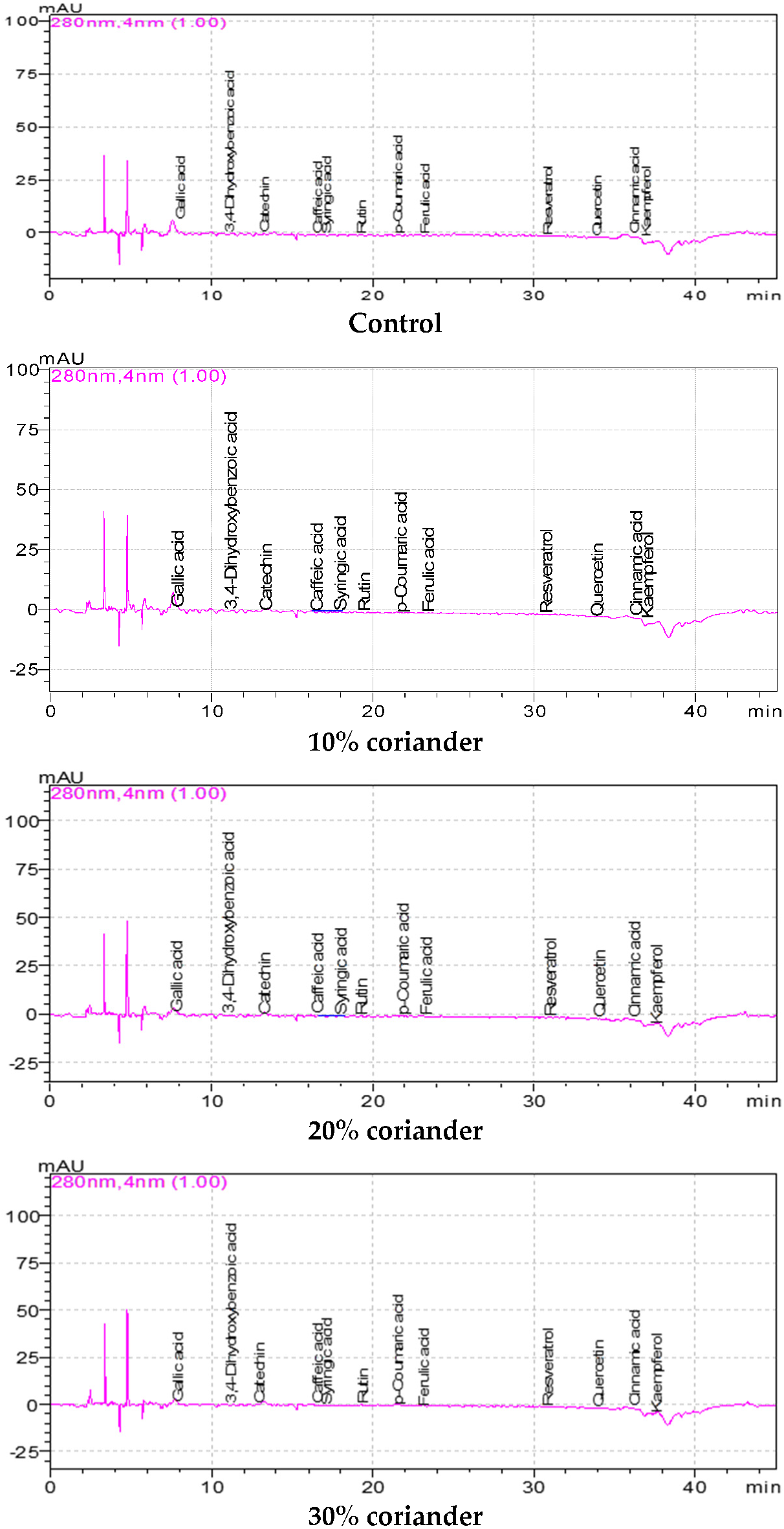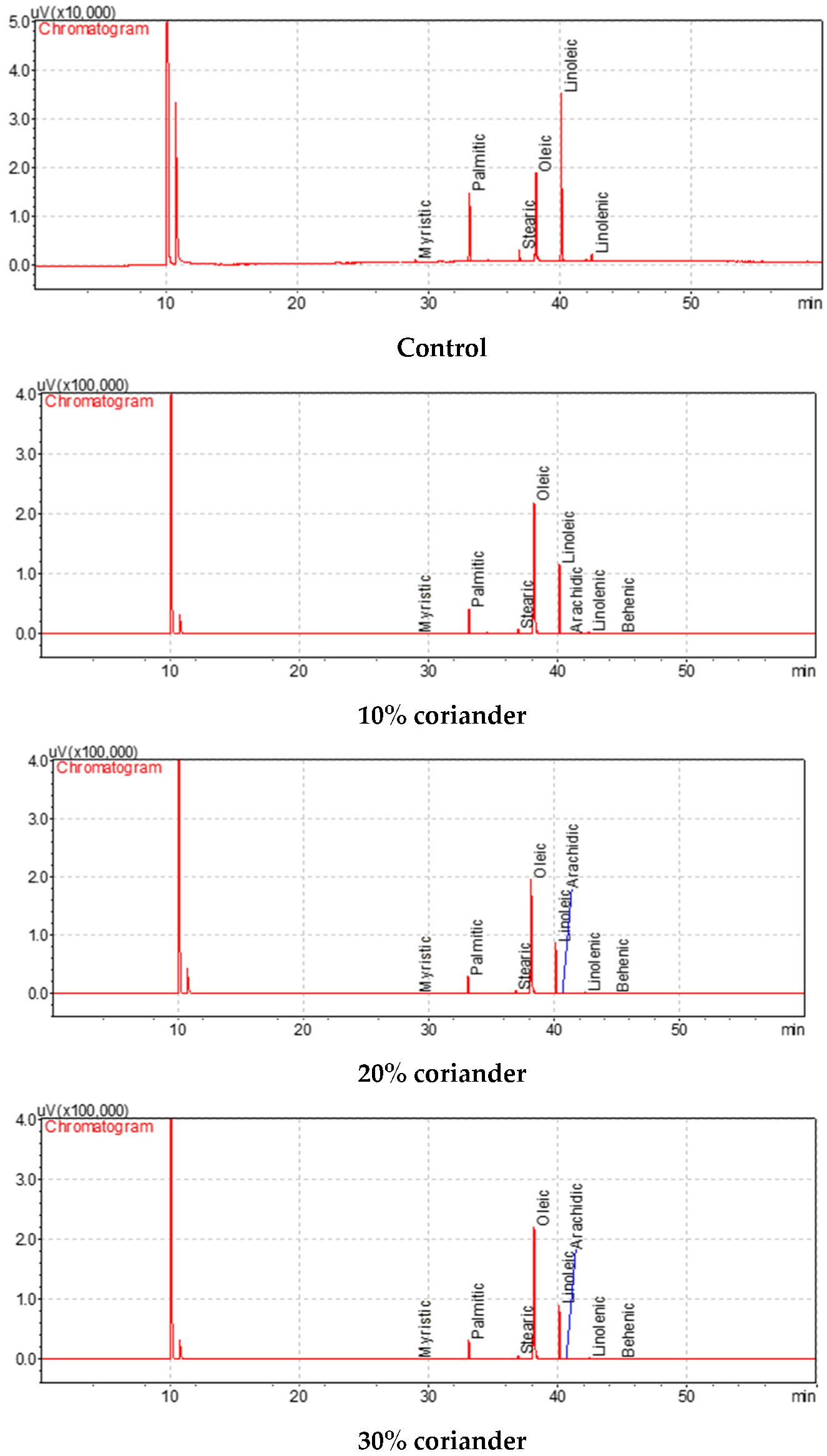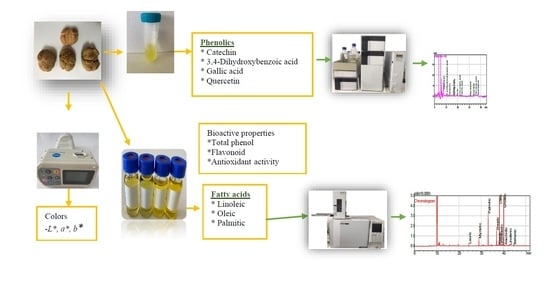Comparison of Physico-Chemical Properties, Phytochemical Compositions and Sensory Characteristics of Wheat Breads Enriched with Coriander Seed Powder
Abstract
1. Introduction
2. Material and Methods
2.1. Material
2.2. Methods
2.2.1. Moisture Content
2.2.2. Color Value
2.2.3. Oil Content
2.2.4. Extraction Procedure
2.2.5. Total Phenolic Content
2.2.6. Total Flavonoid Content
2.2.7. Antioxidant Activity
2.2.8. Phenolic Compounds
2.2.9. Fatty Acid Composition
2.2.10. Sensory Properties
2.3. Statistical Analyses
3. Results and Discussion
3.1. The Physico-Chemical Properties and Antioxidant Activities of Breads with Added Coriander Seed Powder
3.2. The Phenolic Constituents and Their Qualitative Results of Breads with Added Coriander
3.3. The Fatty Acid Composition and Their Qualitative Values of the Oils of Breads with Added Coriander Seed Powder
3.4. Sensory Properties of Breads with Added Coriander Seed Powder
4. Conclusions
Funding
Institutional Review Board Statement
Informed Consent Statement
Data Availability Statement
Conflicts of Interest
References
- Khalil, P.; Masood, S.; Rehman, A.; Iqbal, A.Z.; Islam, Z.; Javaid, N.; Ilyas, A.; Qamar, S.; Zeb, A. Proximate and sensory analysis of wheat bread supplemented with Nigella sativa oil and Nigella sativa extract. Pure Appl. Biol. 2021, 10, 1158–1165. [Google Scholar] [CrossRef]
- Elgün, A.; Ertugay, Z.; Aydın, F.; Kotancılar, G. Sıvı ferment yöntemiyle ekmek üretiminde laktik kültür katkısının etkisi (Effect of lactic culture addition in the bread production with liquid ferment method). Gıda 1991, 16, 227–232. [Google Scholar]
- Rehman, A.U.; Khalil, I.H.; Ali, I. Genetic diversity and traits association in tetraploid and hexaploid wheat genotypes in in Khyber Pakhtunkhwa province of Pakistan. Sarhad J. Agric. 2020, 36, 1112–1118. [Google Scholar] [CrossRef]
- Taylor, J.R.N. Grain production and consumption: Africa. In Encyclopedia of Grain Science; Wrigley, C.C., Corke, H.H., Walker, C.E., Eds.; Elsevier: London, UK, 2004; pp. 70–78. [Google Scholar]
- Mhemdi, H.; Rodier, E.; Kechaou, N.; Fages, J. A supercritical tuneable process for the selective extraction of fats and essential oil from coriander seeds. J. Food Eng. 2011, 105, 609–616. [Google Scholar] [CrossRef]
- Shahwar, M.K.A.; El-Ghorab, F.H.; Anjum, M.; Butt, M.S.; Nadeem, M. Characterization of coriander (Coriandrum sativum L.) seeds and leaves: Volatile and nonvolatile extracts. Int. J. Food Propert. 2012, 15, 736–747. [Google Scholar] [CrossRef]
- Bhat, S.P.; Kaur, M.; Sharma, H.K. Coriander (Coriandrum sativum L.): Processing, Nutritional and Functional Aspects. Afr. J. Plant Sci. 2014, 8, 25–33. [Google Scholar]
- Pandey, S. Coriandrumsativum: A biological description and its uses in the treatment of various diseases. Int. J. Pharm. Life Sci. 2010, 1, 119–126. [Google Scholar]
- Hessain, E.G. Chemical and Biological Studies on Som Hypochelestrolemic and Hypo Glycemic Food. Ph.D. Thesis, Food Indust. Department, Faculty of Agriculture, Mansoura University, Mansoura, Egypt, 2014. [Google Scholar]
- Alison, M.G.; Peter, R.F. Insulin releasing and insulin like activity of the traditional anti-diabetic plant Coriander sativum (coriander). British J. Nutr. 1999, 81, 203–209. [Google Scholar]
- Cortes-Eslava, J.; Gomez-Arroyo, S.; Villalobos-Pietrini, R. Antimutagenicity of coriander (Coriandrum sativum) juice on the mutagenesis produced by plant metabolites of aromatic amines. J. Toxicol. Lett. 2004, 153, 283–292. [Google Scholar] [CrossRef]
- Zein, R.I. Using of coriander seeds (Coriandrum sativum) and their aqueous extract as hypoglycemic agents. J. Agric. Res. Tanta Univ. 2006, 32, 103–133. [Google Scholar]
- Darughe, F.; Barzegar, M.; Sahari, M.A. Antioxidant and antifungal activity of coriander (Coriandrum sativum L.) essential oil in cake. Int. Food Res. J. 2012, 19, 1253–1260. [Google Scholar]
- Eidi, M.; Eidi, A.; Saeidi, A.; Molanaei, S.; Sadeghipour, A.; Bahar, M.; Bahar, K. Effect of coriander seed (Coriandrum sativum L.) ethanol extract on insulin release from pancreatic beta cells in streptozotocininduced diabetic rats. J. Phytother. Res. 2012, 23, 404–406. [Google Scholar] [CrossRef] [PubMed]
- Sunil, C.; Agastian, P.; Kumarappan, C.; Ignacimuthu, S. In vitro antioxidant, antidiabetic and antilipidemic activities of Symplocos cochinchinensis (Lour.) S. Moore bark. J. Food Chem. Toxicol. 2012, 50, 1547–1553. [Google Scholar] [CrossRef] [PubMed]
- Parthasarathy, V.A.; Chempakam, B.; Zachariah, T.J. Coriander: Chemistry of Spices. CAB Int. 2008, 190–206. [Google Scholar]
- Zain, M.Z.M.; Shori, A.B.; Baba, A.S. Potential functional food ingredients in bread and their health benefits. Biointerface Res. Appl. Chem. 2022, 12, 6533–6542. [Google Scholar]
- Granato, D.; Barba, F.J.; Bursać Kovačević, D.; Lorenzo, J.M.; Cruz, A.G.; Putnik, P. Functional foods: Product development, technological trends, efficacy testing, and safety. Annu. Rev. Food Sci. Technol. 2020, 11, 93–118. [Google Scholar] [CrossRef] [PubMed]
- Pagliarini, E.; Rastelli, C. Sensory and instrumental assessment of olive oil appearance. Grasas Aceites 1994, 45, 1–2. [Google Scholar]
- AOAC. Official Methods of Analysis, 15th ed.; Association of Official Analytical Chemists: Washington, DC, USA, 1990. [Google Scholar]
- Abreu, J.; Quintino, I.; Pascoal, B.; Postingher, B.; Cadena, R.; Teodoro, A. Antioxidant capacity, phenolic compound content and sensory properties of cookies produced from organic grape peel (Vitis labrusca) flour. Int. J. Food Sci. Technol. 2019, 54, 1215–1224. [Google Scholar] [CrossRef]
- Yoo, K.M.; Lee, K.W.; Park, J.B.; Lee, H.J.; Hwang, I.K. Variation in major antioxidants and total antioxidant activity of Yuzu (Citrusjunos SiebexTanaka) during maturation and between cultivars. J. Agric. Food Chem. 2004, 52, 5907–5913. [Google Scholar] [CrossRef] [PubMed]
- Hogan, S.; Zhang, L.; Li, J.; Zoecklein, B.; Zhou, K. Antioxidant properties and bioactive components of Norton (Vitis aestivalis) and Cabernet Franc (Vitis vinifera) wine grapes. LWT-Food Sci. Technol. 2009, 42, 1269–1274. [Google Scholar] [CrossRef]
- Lee, S.K.; Mbwambo, Z.H.; Chung, H.S.; Luyengi, L.; Games, E.J.C.; Mehta, R.G. Evaluation of the antioxidant potential of natural products. Comb. Chem. High Throughput Screen. 1998, 1, 35–46. [Google Scholar] [CrossRef]
- ISO-5509; Animal and Vegetable Fats and Oils Preperation of Methyl Esters of Fatty Acids (ISO 5509); ISO-International Organization for Standardization, Vol Method ISO 5509. International Organization for Standardization: Geneve, Switzerland, 1978; pp. 1–6.
- Püskülcü, H.; İkiz, F. Introduction to Statistic; Bilgehan Press: İzmir, Turkey, 1989; p. 333. (In Turkish) [Google Scholar]
- Chinma, C.E.; Avu, J.O.; Abubakar, Y.A. Effect of tigernut (Cyperus esculentus) flour addition on the quality of wheat-based cake. Int. J. Food Sci. Technol. 2010, 45, 1746–1752. [Google Scholar] [CrossRef]
- Lim, H.S.; Park, S.H.; Ghafoor, K.; Hwang, S.Y.; Park, J. Quality and antioxidant properties of bread containing turmeric (Curcuma longa L.) cultivated in South Korea. Food Chem. 2011, 124, 1577–1582. [Google Scholar] [CrossRef]
- Mikulec, A.; Kowalski, S.; Sabat, R.; Skoczyas, L.; Tabaszewska, M.; Wywrocka-Gurgul. Hemp flour as a valuable component for enriching physicochemical and antioxidant properties of wheat bread. LWT-Food Sci. Technol. 2019, 102, 64–172. [Google Scholar] [CrossRef]
- Sanz-Penella, J.M.; Wronkowska, M.; Soral-Smietana, M.; Haros, M. Effect of whole amaranth flour on bread properties and nutritive value. LWT-Food Sci. Technol. 2013, 50, 679–685. [Google Scholar] [CrossRef]
- Balestra, F.; Cocci, E.; Pinnavaia, G.; Romani, S. Evaluation of antioxidant, rheological and sensorial properties of wheat flour dough and bread containing ginger powder. LWT-Food Sci. Technol. 2011, 44, 700–705. [Google Scholar] [CrossRef]
- Babiker, E.E.; Özcan, M.M.; Ghafoor, K.; AlJuhaimi, F.; Ahmed, I.A.M.; Almusallam, I.A. Physico-chemical and bioactive properties, fatty acids, phenolic compounds, mineralcontents, and sensory properties of cookies enriched with carob flour. J. Food Process. Preserv. 2020, 44, 1–10. [Google Scholar] [CrossRef]
- Przygodzka, M.; Zielinski, H.; Ciesarová, Z.; Kukurová, K.; Lamparski, G. Effect of selected spices on chemical and sensory markers in fortified rye-buckwheat cakes. Food Sci. Nutr. 2016, 4, 651–660. [Google Scholar] [CrossRef]
- Tomsone, L.; Galoburda, R.; Kruma, Z.; Majore, K. Physicochemical properties of biscuits enriched with horseradish (Armoracia rusticana L.) products and bioaccessibility of phenolics after simulated human digestion. Pol. J. Food Nutr. Sci. 2020, 70, 419–428. [Google Scholar] [CrossRef]
- Olgun, M.; Budak Başçiftçi, Z.; Ayter, N.G.; Aydın, D. Farklı özellikteki ekmeklik çeşitlerinin duyusal analizler yönünden değerlendirilmesi (Evaluation of different wheat breads for sensory analyses.). Süleyman Demirel Üniv. Zir. Fak. Derg. 2017, 12, 47–54. [Google Scholar]


| Sample | Moisture Content (%) | L* | a* | b* |
|---|---|---|---|---|
| Control | 21.13 ± 0.13 *ab | 69.97 ± 1.53 a | 0.41 ± 0.34 d | 20.30 ± 1.10 d |
| 10% | 21.34 ± 0.58 a ** | 59.74 ± 0.49 b | 3.56 ± 0.23 c | 22.88 ± 0.53 b |
| 20% | 17.22 ± 0.34 d | 55.22 ± 0.43 c | 5.06 ± 0.35 b | 23.83 ± 0.20 a |
| 30% | 18.35 ± 1.45 c | 48.86 ± 1.38 d | 5.46 ± 0.21 a | 21.08 ± 0.71 c |
| Sample | Oil content (%) | Total phenolic content (mg/100 g) | Total flavonoid content (mg/100 g) | Antioxidant activity (mmol/kg) |
| Control | 0.11 ± 0.02 d | 43.13 ± 2.48 d | 72.62 ± 6.63 d | 0.45 ± 0.00 d |
| 10% | 0.50 ± 0.03 c | 58.21 ± 3.44 c | 97.38 ± 3.75 c | 1.20 ± 0.01 bc |
| 20% | 0.84 ± 0.02 b | 62.18 ± 1.29 b | 125.00 ± 3.09 b | 1.21 ± 0.01 b |
| 30% | 1.25 ± 0.08 a | 64.01 ± 4.13 a | 130.71 ± 6.06 a | 1.32 ± 0.01 a |
| Phenolic Compounds (mg/100 g) | Control | 10% | 20% | 30% |
|---|---|---|---|---|
| Gallic acid | 45.21 ± 1.67 *a | 42.77 ± 1.06 b | 12.93 ± 0.36 c | 11.51 ± 1.35 d |
| 3,4-Dihydroxybenzoic acid | 22.88 ± 2.18 b ** | 16.41 ± 0.88 d | 29.39 ± 1.73 a | 18.51 ± 1.62 c |
| Catechin | 40.67 ± 2.07 c | 37.43 ± 1.10 d | 70.12 ± 1.81 a | 54.93 ± 8.90 b |
| Caffeic acid | 7.71 ± 0.96 a | 4.86 ± 1.31 b | 4.60 ± 0.34 bcd | 4.77 ± 0.41 bc |
| Syringic acid | 7.69 ± 0.99 a | 5.03 ± 0.96 b | 4.01 ± 0.45 c | 4.15 ± 0.50 b |
| Rutin | 6.96 ± 0.83 c | 6.76 ± 1.87 cd | 12.48 ± 3.81 b | 29.45 ± 0.41 a |
| p-Coumaric acid | 3.42 ± 0.76 a | 3.15 ± 1.40 b | 1.56 ± 0.28 c | 1.21 ± 0.29 d |
| Ferulic acid | 3.84 ± 1.00 a | 1.71 ± 0.77 b | 1.52 ± 0.33 c | 0.82 ± 0.20 d |
| Resveratrol | 2.33 ± 0.59 a | 1.62 ± 0.69 b | 0.46 ± 0.11 c | 0.18 ± 0.03 d |
| Quercetin | 12.03 ± 3.06 a | 2.67 ± 1.13 b | 0.76 ± 0.09 c | 0.46 ± 0.07 cd |
| Cinnamic acid | 4.51 ± 0.93 a | 1.90 ± 0.69 b | 0.68 ± 0.14 c | 0.56 ± 0.03 d |
| Kaempferol | 9.93 ± 2.06 a | 4.34 ± 1.38 b | 2.12 ± 0.27 c | 1.07 ± 0.16 d |
| Fatty Acids | Control | 10% | 20% | 30% |
|---|---|---|---|---|
| Myristic | 0.77± 0.02 *a | 0.18 ± 0.01 b | 0.16 ± 0.01 c | 0.15 ± 0.00 d |
| Palmitic | 18.42 ± 0.28 a ** | 9.65 ± 0.20 b | 8.78 ± 0.20 c | 7.73 ± 0.16 d |
| Stearic | 3.15 ± 0.01 a | 1.95 ± 0.01 b | 1.93 ± 0.01 b | 1.89 ± 0.00 bc |
| Oleic | 23.15 ± 0.15 d | 55.21 ± 0.17 c | 59.44 ± 0.49 b | 62.45 ± 0.17 a |
| Linoleic | 52.20 ± 0.10 a | 31.76 ± 0.02 b | 28.79 ± 0.02 c | 26.67 ± 0.02 d |
| Arachidic | - *** | 0.21 ± 0.00 b | 0.24 ± 0.01 a | 0.24 ± 0.00 a |
| Linolenic | 2.30 ± 0.03 a | 0.88 ± 0.00 b | 0.74 ± 0.00 c | 0.72 ± 0.01 c |
| Behenic | - | 0.16 ± 0.00 b | 0.19 ± 0.00 a | 0.16 ± 0.01 b |
| Sample | Flavor | Smell | Color | Texture | General View |
|---|---|---|---|---|---|
| Control | 3.17 ± 1.34 *b | 4.00 ± 0.00 a | 4.17 ± 0.69 b | 4.00 ± 0.58 a | 4.00 ± 0.00 |
| 10% | 2.83 ± 1.07 c ** | 3.50 ± 0.96 c | 3.00 ± 0.58 d | 3.33 ± 0.94 c | 3.00 ± 0.63 |
| 20% | 3.17 ± 0.90 b | 3.67 ± 0.75 b | 3.50 ± 0.76 c | 3.33 ± 0.94 c | 3.00 ± 0.63 |
| 30% | 4.17 ± 0.37 a | 4.00 ± 0.58 a | 4.33 ± 0.47 a | 3.50 ± 0.76 b | 3.20 ± 0.40 |
Disclaimer/Publisher’s Note: The statements, opinions and data contained in all publications are solely those of the individual author(s) and contributor(s) and not of MDPI and/or the editor(s). MDPI and/or the editor(s) disclaim responsibility for any injury to people or property resulting from any ideas, methods, instructions or products referred to in the content. |
© 2023 by the author. Licensee MDPI, Basel, Switzerland. This article is an open access article distributed under the terms and conditions of the Creative Commons Attribution (CC BY) license (https://creativecommons.org/licenses/by/4.0/).
Share and Cite
Özcan, M.M. Comparison of Physico-Chemical Properties, Phytochemical Compositions and Sensory Characteristics of Wheat Breads Enriched with Coriander Seed Powder. Foods 2023, 12, 1412. https://doi.org/10.3390/foods12071412
Özcan MM. Comparison of Physico-Chemical Properties, Phytochemical Compositions and Sensory Characteristics of Wheat Breads Enriched with Coriander Seed Powder. Foods. 2023; 12(7):1412. https://doi.org/10.3390/foods12071412
Chicago/Turabian StyleÖzcan, Mehmet Musa. 2023. "Comparison of Physico-Chemical Properties, Phytochemical Compositions and Sensory Characteristics of Wheat Breads Enriched with Coriander Seed Powder" Foods 12, no. 7: 1412. https://doi.org/10.3390/foods12071412
APA StyleÖzcan, M. M. (2023). Comparison of Physico-Chemical Properties, Phytochemical Compositions and Sensory Characteristics of Wheat Breads Enriched with Coriander Seed Powder. Foods, 12(7), 1412. https://doi.org/10.3390/foods12071412







